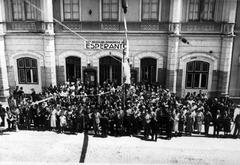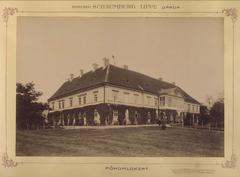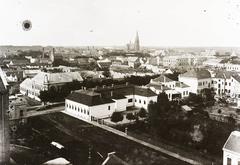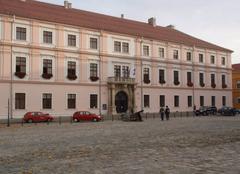Complete Guide to Gradski Vrt Stadium: Visiting Hours, Tickets, and Osijek Historical Sites
Date: 14/06/2025
Introduction
Gradski Vrt Stadium is a cornerstone of Osijek’s sporting, cultural, and historical life. Since its opening in 1958, it has evolved from a local multi-purpose venue to a celebrated landmark representing Croatian football heritage and the community spirit of Osijek. This guide provides thorough, up-to-date information on Gradski Vrt Stadium—including visiting hours, ticketing, accessibility, and nearby historical sites—to help you plan a rewarding visit to Osijek.
Table of Contents
- Introduction
- History and Development
- Architectural Features & Capacity
- Visiting Information
- Gradski Vrt in Croatian Football
- Notable Events & Legacy
- Transition to Opus Arena
- Community and Cultural Significance
- Nearby Attractions & Osijek Historical Sites
- Practical Travel Tips
- FAQs
- Conclusion
- References
History and Development
Origins
Gradski Vrt Stadium—meaning “City Garden”—was constructed during Osijek’s post-war expansion, with building commencing in 1949 and the official opening in 1958. The site was previously a municipal garden dating back to the 18th century, symbolizing the city’s growth and resilience. Initially, the stadium featured basic amenities and a modest capacity, reflecting the economic context of 1950s Yugoslavia.
Evolution and Expansion
The stadium has seen several major renovations. In the 1980s, increased football interest led to expanded stands and improved facilities, accommodating up to 19,000 spectators at its peak. The turn of the 21st century brought further modernization: floodlights, upgraded locker rooms, and enhanced seating. Notable features include the distinctive blue athletics track and open stands, which create an intimate, lively matchday atmosphere.
Architectural Features & Capacity
- Original Capacity: Up to 40,000 (including standing, in the early 1980s)
- Seating (as of 2023): Approximately 18,856 seats, with additional standing spaces
- Stands: Four main stands (North, South, East, West); the West Stand houses VIP areas and lounges
- Facilities: Modern restrooms, concession stands, official shops, and accessibility features
- Other Amenities: Athletics tracks, sports halls, and swimming pools as part of a larger sports complex
The stadium’s architecture blends tradition and function, emphasizing excellent sightlines and proximity to the pitch.
Visiting Information
Visiting Hours
- Monday to Friday: 9:00 AM – 5:00 PM
- Saturday: 10:00 AM – 2:00 PM
- Sunday and Holidays: Closed
Matchdays and special events may affect these hours. Always confirm via the NK Osijek website or the Osijek Tourist Board before your visit.
Tickets & Entry
- Where to Buy: Online through NK Osijek’s official site, at the stadium box office, or via partner ticket offices
- Pricing: Varies by event, seat location, and opponent. Discounts for children, seniors, and groups are available
- Guided Tours: By appointment, arranged through the club or tourist information centers
Accessibility
- Wheelchair-accessible entrances and seating are available
- Parking for visitors with disabilities is offered near the main gates
- Public transport (tram line 2) stops close to the stadium
Visitor Tips
- Arrive at least one hour early on event days for parking and security
- Dress appropriately for weather, as some seats are uncovered
- Photography for personal use is allowed; professional equipment requires prior approval
- Food and beverage kiosks operate during matches; outside food is not permitted
Gradski Vrt in Croatian Football
Gradski Vrt has played a pivotal role in Osijek’s and Croatia’s football history. Home to NK Osijek since 1947, it has witnessed the club’s rise in national leagues and European competitions. The stadium also served as a stronghold for the Croatian national team, hosting 14 matches with only a single defeat—a testament to its fortress-like reputation (Sportske Jutarnji).
Notable Events & Legacy
- International Matches: Key Croatian national team qualifiers and friendlies, including memorable draws and victories
- Club Milestones: Historic matches in the Yugoslav and Croatian leagues, UEFA Cup campaigns, and high-attendance derbies, such as the 1982 clash with Dinamo Zagreb
- Community Events: Athletics competitions, public celebrations, and concerts
Gradski Vrt’s legacy is defined by both sporting triumphs and its role as a gathering place for generations of Osijek residents.
Transition to Opus Arena
In 2023, NK Osijek and the Croatian national team began playing at the newly constructed Opus Arena, a modern venue with a capacity of 13,000+. While top-tier matches have moved, Gradski Vrt remains active for women’s football (ŽNK Osijek), youth events, and community sports (Sportske Jutarnji, NK Osijek website).
Community and Cultural Significance
The stadium is more than just a sports venue—it’s a symbol of Osijek’s resilience, pride, and unity. Over the decades, Gradski Vrt has fostered a vibrant fan culture, especially through the “Kohorta” supporters’ group, and has provided a space for community bonding. Its green surroundings and riverside location enhance its appeal as a city landmark.
Nearby Attractions & Osijek Historical Sites
Enhance your visit by exploring other highlights in Osijek:
- Tvrđa (Osijek Fortress): A baroque fortress and UNESCO candidate, just a short walk away
- Drava River Promenade: Scenic paths for walking, cycling, and river views
- Co-cathedral of St. Peter and Paul: A neo-Gothic cathedral with impressive architecture
- Old Town (Gornji Grad): Historic streets, museums, and vibrant squares
For more on Osijek’s attractions, see the Osijek Tourist Board.
Practical Travel Tips
- Getting There: Tram line 2 from city center; 15-minute walk from the railway station
- Parking: Limited, especially on event days—arrive early
- Accommodation: Wide range of hotels and apartments nearby
- Dining: Numerous restaurants and cafes offer local cuisine around the stadium and old town
- Security: Stadium complies with UEFA safety standards; follow staff instructions and posted rules
Frequently Asked Questions (FAQ)
Q: What are Gradski Vrt Stadium’s visiting hours?
A: Monday–Friday 9:00 AM–5:00 PM, Saturday 10:00 AM–2:00 PM; closed Sundays. Confirm before your visit.
Q: Where can I buy tickets?
A: Online via NK Osijek’s website, at the stadium box office, or through official partners.
Q: Is the stadium accessible for wheelchair users?
A: Yes, with dedicated seating and accessible facilities.
Q: Are guided tours available?
A: Yes, by prior arrangement through the club or tourist center.
Q: What other attractions are nearby?
A: Tvrđa Fortress, Drava River promenade, Osijek Old Town, and museums.
Conclusion
Gradski Vrt Stadium remains a proud emblem of Osijek’s football legacy and urban culture, offering visitors a blend of sports history, architectural charm, and vibrant community life. With accessible facilities, informative tours, and proximity to Osijek’s top attractions, it’s an essential stop for sports fans and travelers alike. For the latest information on visiting hours, tickets, and events, consult the NK Osijek website and Osijek Tourist Board.
Plan your visit to Gradski Vrt Stadium and experience the enduring spirit of Osijek firsthand! For personalized travel insights, download the Audiala app and follow local updates on social media.
References
- Sportske Jutarnji
- NK Osijek Official Website
- Osijek Tourist Board
- Stadium Guide: Gradski Vrt Stadium
- 3LHD Project Details on Gradski Vrt
- Sportski Objekti – Sports Facilities in Osijek
- TravelCroatia.Live - Gradski Vrt Stadium





